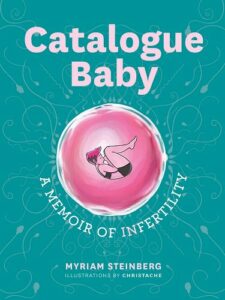Advocate for Yourself: An Interview with Myriam Steinberg

I was thrilled when author Myriam Steinberg contacted me about an interview. First, I love graphic novels, and I was very interested in her debut, Catalogue Baby: A Memoir of (In)fertility. Second, she’s the mother of twins, and I love connecting with folks who have been through some of the same trenches. While our stories are very different, commonalities do, indeed, still exist, and her book spoke to me deeply. Catalogue Baby is also speaking to others deeply. It was listed as one of twelve “[r]ecent memoirs and biographies about remarkable women [that] would make great picks for International Women’s Day” in 2021, and it has won multiple awards as both a graphic novel and a memoir. Readers are especially appreciative. One reviewer wrote, “This topic is unexplored. Usually even fertility memoirs involve the woman having a partner (male or female), [and] seeing a book about a single woman’s dogged pursuit of pregnancy was a welcome insight,” and another reader said, “The artwork is striking and gives an added perspective to the story, making the characters and their emotions live visually on the page. Catalogue Baby is hard to put down and impossible to forget.” Many thanks to Myriam for making time in her schedule for my questions!
Christina: Your first graphic memoir, Catalogue Baby: A Memoir of (In)fertility, tells the story of the “fertility struggles, miscarriages, and [your] deep-seeded desire to bring a child into the world.” What compelled you to write the story and share the story as a graphic memoir? Did you ever contemplate any other genre?
Myriam: As I was going through my journey to kids, living through loss after loss, and struggling with infertility, I’m a very visual person, and I felt that much of what happened to me didn’t have the adequate words to describe it. So much of how I remembered and thought about I saw in pictures—whether as a visual metaphor or as a sequential scene. I thought about making my story a one-woman play, and I thought about creating a blog. Nothing really fit until I came across the graphic novel medium.
Christina: For those of our readers who don’t write graphic memoir or novels, can you give us some insight into your writing process?
Myriam: I have a bit of an unusual process for writing my graphic novel. The “normal” process is to write a script and then do the illustrations (if you’re illustrating yourself) or hand the script to an illustrator. But I write the script and storyboard simultaneously. Often the imagery comes to me before the words, so I sketch it out and then transcribe into words. Sometimes, when I get writer’s block with the words, I move over to sketching. When I get writer’s block with the sketching, I move to words. The interplay of the two also allows me to do a pretty quick and dramatic editing as I go—like when I discover that I wrote too many words to fit in a panel, I have to edit and figure out how to say the same thing more concisely. Sometimes that means cutting words. Sometimes it means drawing more and replacing the words with those drawings. After the storyboards and manuscript are finished, I hand them to the illustrator, and we go through at least three stages of drawings: pencils, inks, and colour, editing even more as we move to the next stage.
Christina: The first part of the book gives a little background on how you became a Single Mom by Choice. In my opinion, you took agency in your situation and made it your own, played on your own terms, terms that fit you and your lifestyle. That takes an enormous amount of courage. When you think of the process now, do you recognize the strength you possess to be where you are today?
Myriam: I do. I was admittedly a bit heartbroken that things hadn’t gone according to my dreams–i.e., meeting someone I truly loved and with whom I was actually compatible and who wanted children. But in retrospect I’m really glad it ended up as it did. My community helped to no end, and I derive my strength in part from my stubborn mule-headed determination to have kids and to the fact that I had an amazing support system.
Christina: Part of what I love about the book is the humor laced through a topic that could be viewed as heavy. Does humor hide the heaviness or help you handle the heaviness or both? Did humor manifest in your life during this time, too, or did that only come out in the writing of the story?
Myriam: Humour doesn’t hide the heaviness. It allows me to survive the heaviness. There were times I ended up in peels of laughter at the most strange and darkest times. Laughter and grief are intimately intertwined. We don’t necessarily have control on how we move from one to the other when emotions run high. A joke can jerk us out of uncontrollable tears in just the same way that a sad memory can cut the laughter short. There were also so many ludicrous moments during the journey that I couldn’t help but laugh at the ridiculousness of it all—like when I was high as a kite after a very painful egg retrieval, or when an emergency doctor couldn’t find my cervix, even after changing the speculum multiple times and changing my position a few times (this isn’t in the book, but I wish it was. It was one of the “darlings” I had to cut).

Christina: Spoiler alert! You not only brought “a child” into the world, you brought two! All pregnancies hold a certain amount of risk, but carrying multiples ups the chances for obstacles, and your babies were born two months premature. What was the best advice someone gave you during your pregnancy? Do you have any tips for those who might be expecting twins (or more)?
Myriam: Ask for help when you need it. Advocate for yourself because the doctors won’t necessarily. Listen to your gut. You know your body best. If you’re expecting multiples, when they’re a baby, get two baby bouncers for every room (joking not joking). Get a night nanny for at least two nights a week, if not more, at least for the first several months. Join a twin parent support group on-line. Also, avoid buying new. Babies grow too fast and there are so many parents desperate to get rid of stuff that their babies have outgrown, that you shouldn’t have to pay for anything until they’re much, much older (especially clothes). I got cribs, a change table, clothes until they’re five years old, and much, much more for free or insanely cheap.
Christina: There is a focus on community support in the book, and you do mention that part of what you decided was to document because you didn’t have one “special person” to have with you on the journey. How can we, the community, do a better job of supporting Single Parents by Choice?
Myriam: I think this is valid for anyone becoming a parent. Food trains, help cleaning the house, hold the baby while parent takes a nap. Listen without judgement. Offer a shoulder to cry on. Things not to say unless prompted by them: “Have you thought of…”
Christina: I’m excited that a sequel (Stick, Stay, Grow) will be out soon! What are you willing to share about it? Did your children directly help in any way? How excited are they for this second memoir to be released?
Myriam: My children are only four so they haven’t done much to help with the book except be the subjects of it while they were in utero and in the NICU. Stick, Stay, Grow is about the conception, high-risk pregnancy (my water broke for one of the twins at 18 weeks), and life in the NICU with the babies. It’s a story of the amazing courage my babies had to survive it all. It also exposes yet another facet of maternal fetal health that no one talks about publicly: what happens when a pregnancy goes south and bed rest and hospitals become part of the routine throughout the entire pregnancy and post-partum period. As a sidenote, although the book may be finished by the end of 2023, it’s looking like it won’t be published in 2023, but I’m hoping it’ll come out either 2024 or 2025. Books always take so much longer to get out into the world officially than we think.
Christina: In an Instagram post, you mention the babies talking in utero, and you end with: “What do you imagine babies are thinking while wiling away the time in a belly?” As a fellow twin mom, I often wondered about that conversation between my girls, but I never asked them. Have you asked your kids what they imagine they were talking about?
Myriam: Not yet, but I did ask them what they thought life was like in utero. I’ve made it a page in the new book. Apparently they were in eggs inside the uterus and in the egg were rainbows and a unicorn for my daughter, and a dinosaur for my son.
Christina: Aside from the second book, what comes next?
Myriam: That’s a good question. I haven’t thought that far yet. Other than getting a job-job? (Is that even a thing for folks doomed to be artists?) I think it’ll be at least a year or two of working on the marketing of the new book and hopefully touring it and getting it out in the world.
Myriam can be found in multiple places!
Website: https://www.cataloguebabynovel.com/
Instagram: @catalogue_baby
Twitter: @cataloguebaby
Facebook: @cataloguebabynovel
Thanks to Myriam for agreeing to this interview! If you know of an artist, author, or podcaster who’d like to be featured in an interview (or you are an author who would like to be featured), feel free to leave a comment or email me via my contact page.

